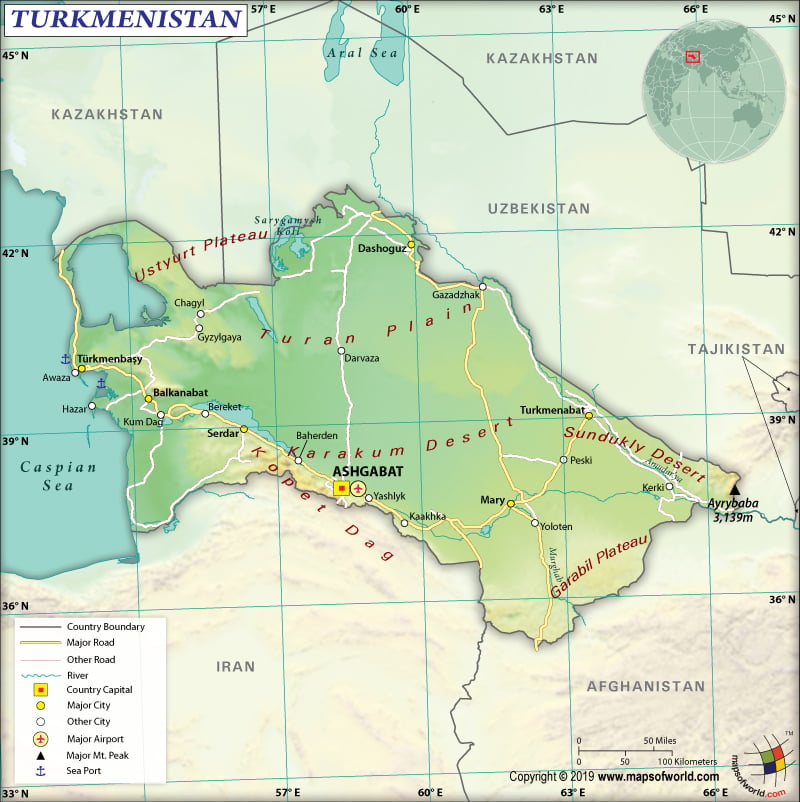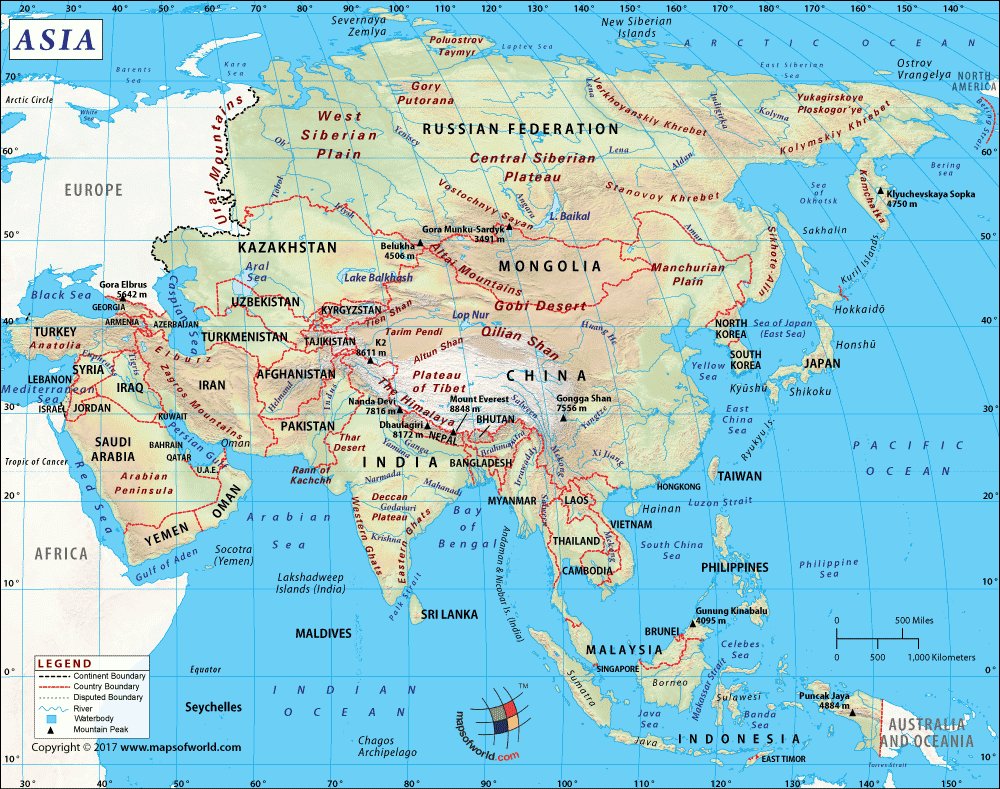What are the Key Facts of Turkmenistan?

|
Official Name |
Republic of Turkmenistan |
|
Continent |
Asia |
|
Capital |
Ashgabat |
|
Largest City |
Ashgabat |
|
Coordinates |
40.000000, 60.000000 |
|
Area |
189,660 sq. mi ( 491,210 sq. km) |
|
Land Boundaries |
2,584 mi ( 4,158 km) |
|
Coastline |
0 mi ( 0 km) landlocked |
|
Currency |
Turkmen new manat (TMT) |
|
Neighboring Countries |
Afghanistan, Iran, Kazakhstan, Uzbekistan |
|
Population |
5,662,544 (2016 est.) |
|
Official Languages |
Turkmen |
|
Major Religion |
Islam |
|
National Day |
27 October (Independence Day) |
|
National Anthem |
“Garassyz, Bitarap Turkmenistanyn” |
|
Form of Government |
Unitary presidential republic, authoritarian dictatorship |
|
President |
Gurbanguly Berdimuhamedow |
|
Vice President |
Raşit Meredow |
|
GDP per capita (PPP) |
$ 19,270.1 (World Bank, 2018) |
|
GDP per capita (nominal) |
$ 6,966.6 (World Bank, 2018) |
|
HDI |
0.706 (2017), Rank: 108 |
|
Literacy Rate (%) |
99.70 (UNESCO, 2014) |
|
Space Agency |
Turkmenistan National Space Agency |
|
Military Expenditure Ranking |
NA (SIPRI, 2017) |
|
No. of Olympic Medals |
0 (as of 2018) |
|
Driving Side |
right |
|
Calling Code |
+993 |
|
Time Zone |
UTC+5 (TMT) |
|
Internet TLD |
.tm |
Where is Turkmenistan?
Turkmenistan is a Central Asian country that is located between Kazakhstan and Iran. It borders the Caspian Sea.
What is the Geography of Turkmenistan?
The total area of Turkmenistan is 491,210 sq. km (189,660 sq. mi), out of which 469,930 sq. km (181,441 sq. mi) is land area and 18,170 sq. km (7,015 sq. mi) is water area. The country has a 4,158 km (2,584 mi) long land boundary, which is shared with 4 neighboring countries: Uzbekistan (1,793 km or 1,114 mi), Iran (1,148 km or 713 mi), Afghanistan (804 km or 500 mi), and Kazakhstan (413 km or 257 mi).
The landform of Turkmenistan is dominated by the flat Kara Kum desert, which is spread from north to south. This part of the terrain is sandy and scrubby, which has a limited potential for agriculture. The south-central border of Turkmenistan along Iran is covered by the Kopetdag Mountain Range. Earthquakes are very common in this part of the country.
The highest elevation point of the country is Gora Ayribaba at 3,139 m (10,299 ft), which is located in the Pamir Mountain Range, extending across the far eastern border of Turkmenistan. The major mountains of the country are Gora Ziyerati Chnagurak, Bugor Daderanly, Bugor Yannydepe, Gora Karababa, Gora Dengli-Dag, etc.
The lowest elevation point of the country is Vpadina Akchanaya at -81 m (-266 ft). The mean elevation point of the Republic of Turkmenistan is 230 m (755 ft). The land elevations below the sea level (especially the Sarykamish Lake’s shorelines and along the Caspian Sea) continues for many miles inland.
The most important rivers in Turkmenistan are Amu Darya, Morghab River, Tejen River, Atrek River, etc. There are some major lakes too in the country and some of them are Sarygamysh, Kattashor, Hanhowuz Reservoir, etc.
The climate in Turkmenistan is arid continental, characterized by sunny and scorching hot summers and cold winters. The weather is unstable as there are different air masses present in the country. Both heat waves and cold waves take place here. Dust storms are raised when the wind starts blowing strongly.
Due to the presence of the Karakum Desert, the temperature during the summertime can reach 50 °C (122 °F). The coasts present along the Caspian Sea have milder winter and the summer is comparatively less hot but more humid.
The northern parts of the country get colder in winter, where the average temperature revolves around 0 °C or 32 °F. However, in the southern and the central parts of the country, the winter is milder than that of the north. The average temperature in the south revolves around 5/6 °C (41/43 °F).
The summertime remains hot everywhere in the country. In July, the average temperature revolves around 27/28 °C (81/82 °F) in the northern parts as well as on the Caspian Sea’s shores. In the central and southern parts of Turkmenistan, the average temperature exceeds 30 °C (86 °F).
The southwest region has the mildest temperature. While the summer remains less hot and more humid, the winter remains less cold.
What is the Economy of Turkmenistan?
Turkmenistan is one of the fastest-growing economies in the world. The nominal GDP grew at 6.2% in 2018 to reach $40,761 million. Though most parts of the country are covered by desert, intensive agriculture is performed in the irrigated areas. While agriculture accounts for just 8% of the GDP, around 50% of the workforce is dependent upon it.
In 2017, Turkmenistan had a positive trade balance of US$3.75 billion. While it exported $7.1 billion, it imported $3.35 billion value of goods and services. The major export items were petroleum gas, refined petroleum, crude petroleum, raw cotton, non-retail pure cotton yarn, etc. The major items imported by the country are harvesting machinery, iron structures, tractors, cranes, and packaged medicaments.
The unemployment rate of the country was 3.78% in 2018. The rate of poverty has continued to remain high despite the high GDP growth rate. In 1999, the poverty rate was 58%. The poverty rate came down to 34.4% in 2001. In 2009, as per a World Bank official, the poverty rate was above 20% of the population.
What is the Transportation System of Turkmenistan?
There are 58,592 km (36,407 mi) of roadway available in the country, out of which 47,577 km (29,563 mi) is paved and the rest 11,015 km (6,844 mi) is unpaved. Around 5,113 km (3,177 mi) of the broad-gauge railway network is also available in Turkmenistan.
Most of the inland water-navigation takes place on the Amu Darya River and Kara Kum Canal. Turkmenbasy is the major seaport in the country. 1,300 km (808 mi) of waterway along with 72 merchant marine ships are present.
There are 26 airports in the Republic of Turkmenistan, out of which 21 have paved runways and 5 have unpaved runways. 1 heliport is also there in the country. The main international airports of Turkmenistan are Oguz Han International Airport, Mary International Airport, etc.
What International Organizations is Turkmenistan part of?
UN, WHO, IMF, UNESCO, ADB, EAPC, EBRD, ECO, FAO, G-77, IBRD, ICAO, ICRM, IDA, IDB, IFC, IFRCS, ILO, IMO, Interpol, IOC, ITU, MIGA, NAM, OIC, OPCW, OSCE, PFP, UNCTAD, UNHCR, UNIDO, UNWTO, UPU, WCO, WIPO, WMO, IOM (observer), CIS (associate member, has not ratified the 1993 CIS charter although it participates in meetings and held the chairmanship of the CIS in 2012), ISO (correspondent), WFTU (NGOs)


